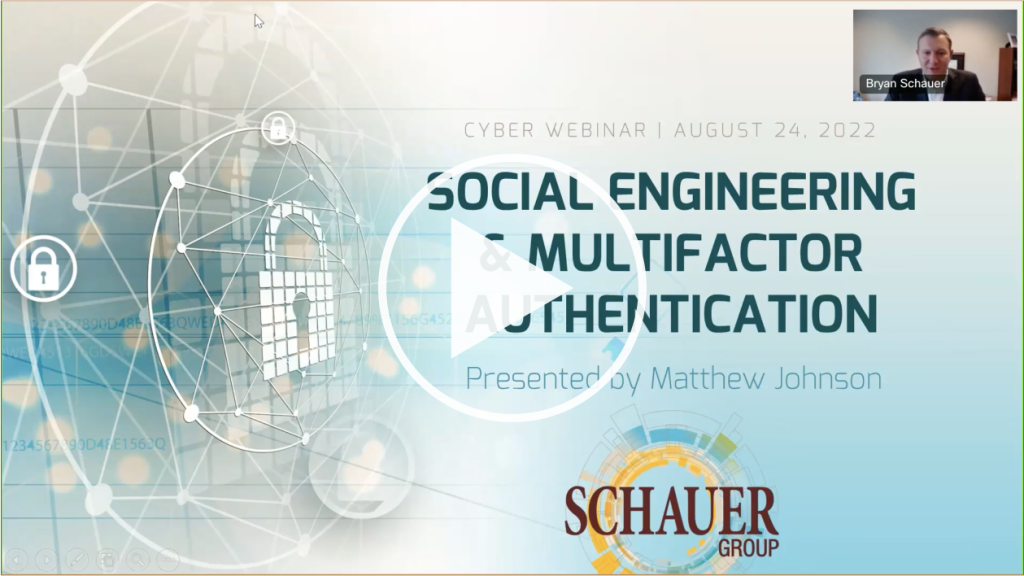
It has never been more important to protect yourself and your business from cyber events.
Insurers are being more selective during the underwriting process, increasing premiums, reducing capacity, and restricting coverage terms. There are certain criteria your organization needs to meet in order to even be considered for coverage.
Learn more about cyber threats by reviewing our Cyber Portal Library below.
Cyber Webinar: Social Engineering & Multi-Factor Authentication | August 24, 2022
CYBER PORTAL LIBRARY
OVERVIEW & DEFINITIONS
Cyber Liability – Watch for These 6 Phishing Scams
Protect yourself and your business by recognizing and reporting phishing threats. Here’s a guide on how to spot some of the most common phishing scams.
Email Multi-Factor Authentication Helps Shut Cyber Criminals Out
A compromised inbox is a treasure trove of corporate information that can then be exploited by a cunning criminal.
Be Cyber Smart: Multi-Factor Authentication
By applying multi-factor verification to more of your accounts, such as email, social media, and more, you can better secure your information and identity online.
Understanding and Preventing Data Breaches
It is often assumed that smaller businesses can escape attention from cyber crooks, but according to industry experts, an increasing number of data breaches are occurring at companies with fewer than 100 employees.
The Importance of Two-factor Authentication
While no cyber security method is foolproof, using two-factor authentication can add an extra layer of security to your online accounts.
Penetration Testing Explained
It’s not enough to simply protect workplace technology with software and security protocols. It’s also critical for your organization to test the overall effectiveness of these protocols on a regular basis. That’s where penetration testing can help.
Employee Cyber Training: Passwords
Making a strong password is really important. But one strong password won’t keep you secure. With the rise of corporate data breaches, learn the best strategy to keep all of your accounts secure from cyberattack.
Cyber Security for Your Small Business
Recent surveys suggest that many small business owners are still operating under a false sense of cyber security.
Cybercrime: Preparing Your Business is Crucial
Our job as your trusted risk management expert is to educate and inform you and your management team of changes and developments in all manner of risks affecting your business. The most alarming and rapidly expanding exposure our clients are currently facing is cybercrime, including malware, ransomware and phishing.
COVERAGE INSIGHTS
Complying with HIPAA
It’s important to remember that HIPAA protects patients, not covered entities. That’s why it’s critical that your organization has a cyber liability insurance policy to cover any potential data breaches.
CGL Versus Specialized Cyber Liability Coverage
Because of the increase in the number of intangible assets companies possess, and the number of companies doing business on the Internet, new types of liability coverages have emerged to meet specific needs.
PREVENTION TECHNIQUES
Cybersecurity safeguards for high-net-worth individuals
For high-net-worth and ultra-high-net-worth individuals, the effects of a cybersecurity attack can be costly and wide-reaching.
Cyber Liability – Watch for These 6 Phishing Scams
Protect yourself and your business by recognizing and reporting phishing threats. Here’s a guide on how to spot some of the most common phishing scams.
Email Multi-Factor Authentication Helps Shut Cyber Criminals Out
A compromised inbox is a treasure trove of corporate information that can then be exploited by a cunning criminal.
Be Cyber Smart: Multi-Factor Authentication
By applying multi-factor verification to more of your accounts, such as email, social media, and more, you can better secure your information and identity online.
Cyber Security Policy Sample
Download and adapt this sample Cyber Security Policy for your organization. A Cyber Security Policy forms the foundation of the corporate Information Security Program and enables the IT team to manage the security of information assets and maintain accountability.
Understanding and Preventing Data Breaches
It is often assumed that smaller businesses can escape attention from cyber crooks, but according to industry experts, an increasing number of data breaches are occurring at companies with fewer than 100 employees.
The Importance of Two-factor Authentication
While no cyber security method is foolproof, using two-factor authentication can add an extra layer of security to your online accounts.
Mitigating BYOD and E-discovery Risks
While there are numerous benefits of implementing a BYOD policy at your workplace, it can be problematic from an e-discovery standpoint, should your company enter litigation.
Reducing Supply Chain Cyber Exposure
Cyberattacks on global supply chains can cause irreparable harm to an organization’s operational, financial and reputational wellness. While it’s not possible to totally eliminate supply chain risk, there are several steps your organization can take to reduce your supply chain exposure.
White House Issues Ransomware Prevention Guidance to Businesses
As ransomware attacks continue to rise in both cost and frequency throughout the country, the federal government is urging businesses to take this evolving cyber threat seriously.
RANSOMWARE
Ransomware Considerations for Board Members
It’s important for board members to be actively involved in developing and promoting effective workplace cybersecurity measures—especially as it pertains to ransomware attacks.
White House Issues Ransomware Prevention Guidance to Businesses
As ransomware attacks continue to rise in both cost and frequency throughout the country, the federal government is urging businesses to take this evolving cyber threat seriously.
TEMPLATES & POLICIES
Cyber Security Policy Sample
Download and adapt this sample Cyber Security Policy for your organization. A Cyber Security Policy forms the foundation of the corporate Information Security Program and enables the IT team to manage the security of information assets and maintain accountability.

